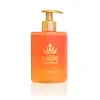What's inside
What's inside
 Benefits
Benefits

 Concerns
Concerns

 Ingredients Side-by-side
Ingredients Side-by-side

Water
Skin ConditioningSodium Laureth Sulfate
CleansingCocamidopropyl Betaine
CleansingGlycerin
HumectantAloe Barbadensis Leaf Juice
Skin ConditioningBenzoic Acid
MaskingDehydroacetic Acid
PreservativeDisodium EDTA
Ethylhexylglycerin
Skin ConditioningGuar Hydroxypropyltrimonium Chloride
Skin ConditioningLaureth-2
CleansingPanthenol
Skin ConditioningParfum
MaskingPEG-90 Glyceryl Isostearate
CleansingPhenoxyethanol
PreservativePolyquaternium-7
Polyquaternium-10
Potassium Sorbate
PreservativeSodium Benzoate
MaskingSodium Chloride
MaskingSodium Dehydroacetate
PreservativeSucrose Cocoate
EmulsifyingWater, Sodium Laureth Sulfate, Cocamidopropyl Betaine, Glycerin, Aloe Barbadensis Leaf Juice, Benzoic Acid, Dehydroacetic Acid, Disodium EDTA, Ethylhexylglycerin, Guar Hydroxypropyltrimonium Chloride, Laureth-2, Panthenol, Parfum, PEG-90 Glyceryl Isostearate, Phenoxyethanol, Polyquaternium-7, Polyquaternium-10, Potassium Sorbate, Sodium Benzoate, Sodium Chloride, Sodium Dehydroacetate, Sucrose Cocoate
Aloe Barbadensis Leaf Juice
Skin ConditioningCocamidopropyl Hydroxysultaine
CleansingSodium C14-16 Olefin Sulfonate
CleansingDecyl Glucoside
CleansingPolyquaternium-7
Glycerin
HumectantCocoyl Hydrolyzed Quinoa Protein
Polysorbate 20
EmulsifyingOlive Oil Glycereth-8 Esters
EmollientGuar Hydroxypropyltrimonium Chloride
Skin ConditioningAleurites Moluccanus Seed Oil
Skin ConditioningMacadamia Ternifolia Seed Oil
EmollientHelianthus Annuus Seed Extract
Skin ConditioningHydroxytyrosol
BleachingParfum
MaskingPhenoxyethanol
PreservativeCaprylyl Glycol
EmollientEthylhexylglycerin
Skin ConditioningPolyquaternium-44
Citric Acid
BufferingAloe Barbadensis Leaf Juice, Cocamidopropyl Hydroxysultaine, Sodium C14-16 Olefin Sulfonate, Decyl Glucoside, Polyquaternium-7, Glycerin, Cocoyl Hydrolyzed Quinoa Protein, Polysorbate 20, Olive Oil Glycereth-8 Esters, Guar Hydroxypropyltrimonium Chloride, Aleurites Moluccanus Seed Oil, Macadamia Ternifolia Seed Oil, Helianthus Annuus Seed Extract, Hydroxytyrosol, Parfum, Phenoxyethanol, Caprylyl Glycol, Ethylhexylglycerin, Polyquaternium-44, Citric Acid
Ingredients Explained
These ingredients are found in both products.
Ingredients higher up in an ingredient list are typically present in a larger amount.
Aloe Barbadensis Leaf Juice comes from leaves of the aloe plant. Aloe Barbadensis Leaf Juice is best known for helping to soothe sunburns. It is also anti-inflammatory, moisturizing, antiseptic, and can help heal wounds.
Aloe is packed with good stuff including Vitamins A, C, and E. These vitamins are antioxidants, which help fight free-radicals and the damage they may cause. Free-radicals are molecules that may damage your skin cells, such as pollution.
Aloe Barbadensis Leaf Juice also contains sugars. These sugars come in the form of monosaccharides and polysaccharides, folic acid, and choline. These sugars are able to help bind moisture to skin.
It also contains minerals such as calcium, 12 anthraquinones, fatty acids, amino acids, and Vitamin B12.
Learn more about Aloe Barbadensis Leaf JuiceEthylhexylglycerin (we can't pronounce this either) is commonly used as a preservative and skin softener. It is derived from glyceryl.
You might see Ethylhexylglycerin often paired with other preservatives such as phenoxyethanol. Ethylhexylglycerin has been found to increase the effectiveness of these other preservatives.
Glycerin is already naturally found in your skin. It helps moisturize and protect your skin.
A study from 2016 found glycerin to be more effective as a humectant than AHAs and hyaluronic acid.
As a humectant, it helps the skin stay hydrated by pulling moisture to your skin. The low molecular weight of glycerin allows it to pull moisture into the deeper layers of your skin.
Hydrated skin improves your skin barrier; Your skin barrier helps protect against irritants and bacteria.
Glycerin has also been found to have antimicrobial and antiviral properties. Due to these properties, glycerin is often used in wound and burn treatments.
In cosmetics, glycerin is usually derived from plants such as soybean or palm. However, it can also be sourced from animals, such as tallow or animal fat.
This ingredient is organic, colorless, odorless, and non-toxic.
Glycerin is the name for this ingredient in American English. British English uses Glycerol/Glycerine.
Learn more about GlycerinThis ingredient is derived from guar gum.
It is a conditioning ingredient, meaning it helps soften skin and hair.
Parfum is a catch-all term for an ingredient or more that is used to give a scent to products.
Also called "fragrance", this ingredient can be a blend of hundreds of chemicals or plant oils. This means every product with "fragrance" or "parfum" in the ingredients list is a different mixture.
For instance, Habanolide is a proprietary trade name for a specific aroma chemical. When used as a fragrance ingredient in cosmetics, most aroma chemicals fall under the broad labeling category of “FRAGRANCE” or “PARFUM” according to EU and US regulations.
The term 'parfum' or 'fragrance' is not regulated in many countries. In many cases, it is up to the brand to define this term.
For instance, many brands choose to label themselves as "fragrance-free" because they are not using synthetic fragrances. However, their products may still contain ingredients such as essential oils that are considered a fragrance by INCI standards.
One example is Calendula flower extract. Calendula is an essential oil that still imparts a scent or 'fragrance'.
Depending on the blend, the ingredients in the mixture can cause allergies and sensitivities on the skin. Some ingredients that are known EU allergens include linalool and citronellol.
Parfum can also be used to mask or cover an unpleasant scent.
The bottom line is: not all fragrances/parfum/ingredients are created equally. If you are worried about fragrances, we recommend taking a closer look at an ingredient. And of course, we always recommend speaking with a professional.
Learn more about ParfumPhenoxyethanol is a preservative that has germicide, antimicrobial, and aromatic properties. Studies show that phenoxyethanol can prevent microbial growth. By itself, it has a scent that is similar to that of a rose.
It's often used in formulations along with Caprylyl Glycol to preserve the shelf life of products.
Polyquaternium-7 is a light to clear colored liquid. It is commonly found in haircare products for its film-forming and anti-static properties.
According to a manufacturer, it is a non-paraben and specially developed for negatively charged surfactant systems. This makes it a great hairstyle holder and helps to improve wet hair detangling without adding buildup.